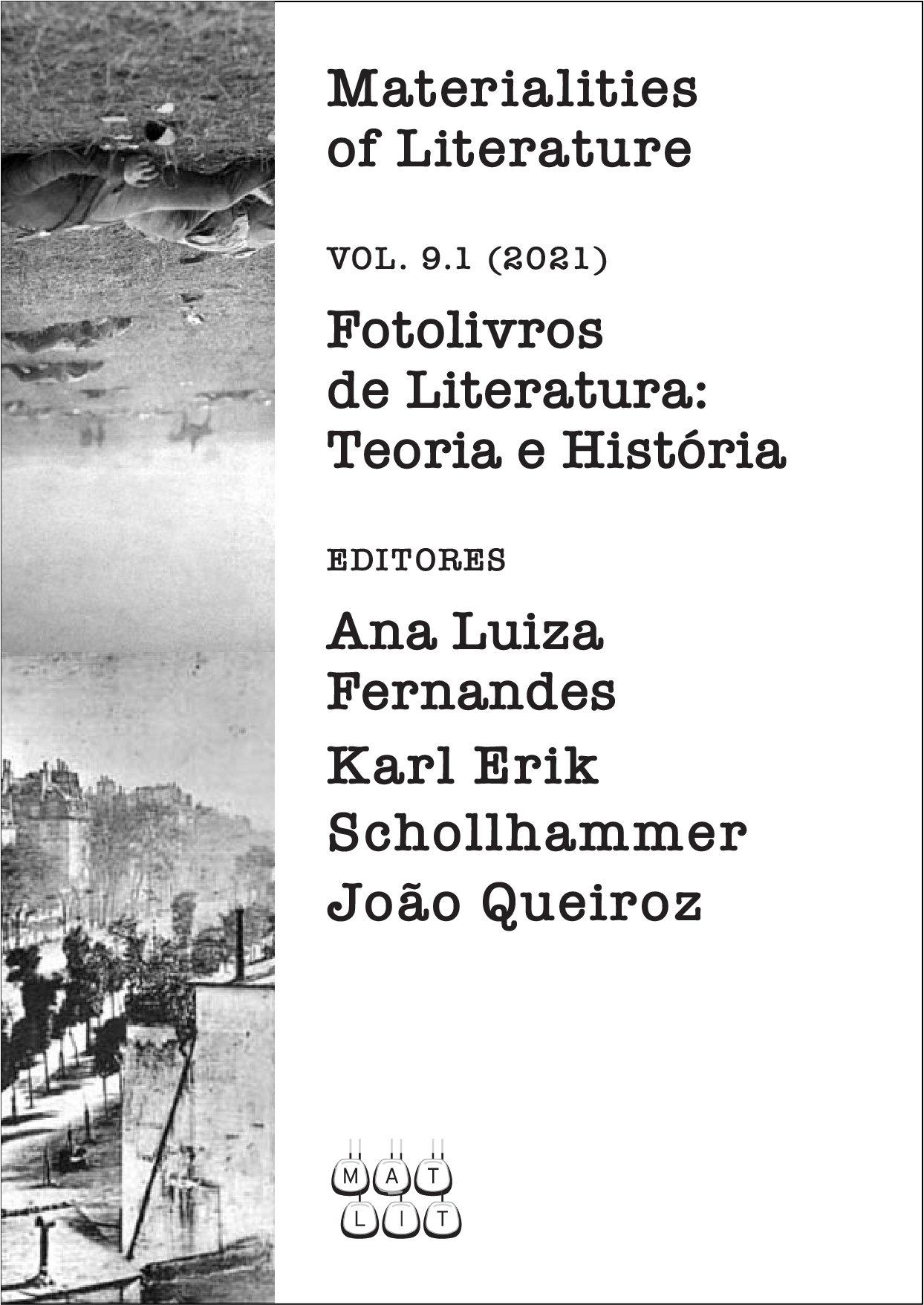The photography book and the library: a case study
DOI:
https://doi.org/10.14195/2182-8830_9-1_3Keywords:
photography books, visual literacy, library science, specialized libraries, photographyAbstract
This article aims to provide some basic contextualization for the understanding of photography books according to Library Science. Photographic books – especially the so-called photobooks – are presented as documents with informational potential for visual literacy practices and, consequently, as potential tools that can be used by educators and readers in order to support the development of critical abilities and reflections around the visual messages disseminated by the media. This study also presents the main characteristics of this kind of document and the ways in which it is used by readers in the context of a specialized library dedicated exclusively to photographic books. With this aim we have analysed the history of searches in the Photography Library catalogue at Instituto Moreira Salles, in São Paulo, from which we identified and classified the main keywords used for searches.
Downloads
References
ARMSTRONG, Carol (1998). Scenes in a Library: Reading the Photograph in the Book, 1843–1875. Cambridge, MA: MIT Press.
AVGERINOU, Maria D. (2012). “What Is Visual Literacy?”. IVLA International Visual Literacy Association. https://ivla.org/about-us/visual-literacy-explained/ [21 julho 2019].
BARATIN, Marc, e Christian Jacob, eds. (2000). O Poder das Bibliotecas: a memória dos livros no Ocidente. Rio de Janeiro: Editora UFRJ.
BURKE, Peter (2012). Uma História Social do Conhecimento II: da Enciclopédia à Wikipédia. Rio de Janeiro: Zahar.
BURNS, Mary (2006). “A Thousand Words: Promoting Teachers’ Visual Literacy Skills”. MultiMedia & Internet@Schools 13.1: 16-20. https://www.proquest.com/trade-journals/thousand-words-promoting-teachers-visual-literacy/docview/229749865/se-2?accountid=201395 [15 abril 2021].
CRIMP, Douglas (1992). “The Museum’s Old / The Library’s New Subject”. The Contest of Meaning: Critical Histories of Photography. Ed. Richard Bolton. Cambridge, MA: MIT Press. 3-11.
DUBOIS, Philippe (1993). O ato fotográfico e outros ensaios. Campinas: Papirus.
FABRIS, Annateresa (2016). "Na encruzilhada: arte e fotografia no começo do século XX". O desafio do olhar: Fotografia e artes visuais no período das vanguardas históricas. São Paulo: Martins Fontes. 17-72.
FELDHUES, Marina (2018). “Fotolivros: (in)definições”. Congresso de Ciências da Comunicação na Região Nordeste 20. https://www.academia.edu/37027313/Fotolivros_in_definições [15 abril 2021].
FRIZOT, Michel (1998). The New History of Photography. Colônia: Könemann.
GASTAMINZA, Félix Del Valle (2010). Manual de Documentación Fotográfica. Madrid: Síntesis.
GRAHAM, Paul (2007). A Shimmer of Possibility. Goettingen: SteidlMack.
GUIMARÂES, Sérgio (1977). Da Resistência à Libertação. Lisboa: Mil dias.
HARRIS, Benjamin R. (2010). “Blurring borders, visualizing connections”. Reference Services Review 38.4: 523-535. DOI: https://doi.org/10.1108/00907321011090700 [15 abril 2021]
MIGUEL, Maria Lúcia Cerutti (1993). “A fotografia como documento: uma instigação à leitura”. Acervo 6.1/2: 121-132. http://revista.arquivonacional.gov.br/index.php/revistaacervo/issue/view/28 [15 abril 2021].
NELSON, Andrea Jeannette (2007). Reading Photobooks: narrative montage and the construction of modern visual literacy. Tese (PhD). University of Minnesota, Minnesota.
SÁNCHEZ, Jonathan Paredes (2018). Análisis del fotolibro contemporáneo como una plataforma de educación visual. Tese de licenciatura (graduação). México: Facultad de Estudios Superiores Cuautitlán, Universidad Autónoma de México.
SMIT, Johanna W. (1987). “A análise da imagem: um primeiro plano”. Análise documentária: a análise da síntese. Ed. Johanna W. Smit. Brasília: IBICT. 100-111.
SMIT, Johanna W. (1996). “A representação da imagem”. INFORMARE – Cadernos do Programa de Pós-Graduação em Ciência da Informação 2.2: 28-36.
SUNDT, Christine L. (2002). “The Image User and the Search for Images”. Introduction to Art Image Access: Issues, Tools, Standards, Strategies. Ed. Murtha Baca. Los Angeles: Getty Research Institute. 67-85.
VITTURI, Lorenzo (2014). Dalston anatomy. Londres: SPBH.
WILKIE, Theresa, e Jane Pendlebury (2012). “Locating Photography and the Artist’s Book”. Photography and the Artist’s Book. Eds. Theresa Wilkie, Jonathan Carson, e Rosie Miller. Cambridge: MuseumsEtc. 62-89.
WHITE, Maria (2012). “Foreword”. Photography and the Artist’s Book. Eds. Theresa Wilkie, Jonathan Carson, e Rosie Miller. Cambridge: MuseumsEtc. 10-13.
Published
How to Cite
Issue
Section
License
Copyright (c) 2021 Renata Fernandes Veloso Baralle, Marivalde Moacir Francelin

This work is licensed under a Creative Commons Attribution 4.0 International License.
MATLIT embraces full open access to all issues. Authors who publish with this journal agree to the following terms:
- Authors retain copyright and grant the journal right of first publication with the work simultaneously licensed under a Creative Commons Attribution- 4.0 International (CC BY 4.0) that allows others to share the work with an acknowledgement of the work's authorship and initial publication in this journal.
- Authors are able to enter into separate, additional contractual arrangements for the non-exclusive distribution of the journal's published version of the work (e.g., post it to an institutional repository or publish it in a book), with an acknowledgement of its initial publication in this journal.
- Authors are permitted and encouraged to post their work online (e.g., in institutional repositories or on their website) prior to and during the submission process, as it can lead to productive exchanges, as well as earlier and greater citation of published work (See The Effect of Open Access).
- A CC licensing information in a machine-readable format is embedded in all articles published by MATLIT.
- Attribution — You must give appropriate credit, provide a link to the license, and indicate if changes were made. You may do so in any reasonable manner, but not in any way that suggests the licensor endorses you or your use.
- No additional restrictions — You may not apply legal terms or technological measures that legally restrict others from doing anything the license permits.
Notices:
- You do not have to comply with the license for elements of the material in the public domain or where your use is permitted by an applicable exception or limitation.
- No warranties are given. The license may not give you all of the permissions necessary for your intended use. For example, other rights such as publicity, privacy, or moral rights may limit how you use the material.




